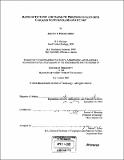| dc.contributor.advisor | Samuel A. Bowring. | en_US |
| dc.contributor.author | Matzel, Jennifer E. Piontek, 1973- | en_US |
| dc.contributor.other | Massachusetts Institute of Technology. Technology, Dept. of Earth, Atmospheric, and Planetary Sciences. | en_US |
| dc.date.accessioned | 2006-03-24T18:37:32Z | |
| dc.date.available | 2006-03-24T18:37:32Z | |
| dc.date.copyright | 2004 | en_US |
| dc.date.issued | 2004 | en_US |
| dc.identifier.uri | http://hdl.handle.net/1721.1/30292 | |
| dc.description | Thesis (Ph. D.)--Massachusetts Institute of Technology, Dept. of Earth, Atmospheric, and Planetary Sciences, 2004. | en_US |
| dc.description | Includes bibliographical references. | en_US |
| dc.description.abstract | Continental magmatic arcs are among the most dynamic. geologic systems, and documentation of the magmatic, thermal, and tectonic evolution of arcs is essential for understanding the processes of magma generation, ascent and crustal growth. The primary goal of this research is to determine rates of tectonic and magmatic processes in the mid to deep crustal levels of the crystalline core of the Cretaceous North Cascades arc. This region was selected for study because it preserves a -10-40 km depth-section through the arc, which allows an assessment of magmatic and structural processes over a range of crustal levels. The relatively young age of the arc (ca. 100-45 Ma) and the inherent high-precision of U-Pb zircon dates permit absolute uncertainties of <100 ky. Meta-supracrustal rocks of the Cascades core record some of the highest pressures obtained in the North American Cordillera. The timing of deposition and metamorphism of the 9-12 kbar Swakane Gneiss constrain tectonic burial models and the timescales of large crustal displacements within an arc setting. These models involve rapid burial (-7 mm/yr) of a fore- or back-arc basin from ca. 73-68 Ma. Nd isotopic signatures of all meta-clastic terranes of the Cascades core reflect mixing of arc- and craton-derived sediment, and the Swakane Gneiss has the most isotopically-evolved signature of these terranes. Nd isotopic signatures of plutons that intrude the core lack evidence of melting of this isotopically-evolved unit. 40Ar/39Ar and U-Pb thermochronologic data define regional cooling patterns that suggest mid- to Late Cretaceous exhumation coincident with contraction and crustal thickening at the deepest levels of the core, followed by Early Tertiary extension. | en_US |
| dc.description.abstract | (cont.) High-precision U-Pb geochronology reveals internal complexities inherent in the construction of an intrusive magmatic system. The Mount Stuart batholith was constructed over a ca. 5.6 Myr time period with four punctuated intervals of magma emplacement, whereas the Tenpeak intrusion was emplaced in a more continuous process over ca. 2.7 Myr time period. U-Pb zircon dates from two elongate intrusions, the Seven- Fingered Jack and Entiat suites, suggest that they were constructed from multiple magmatic sheets that were partially homogenized at the level of emplacement. | en_US |
| dc.description.statementofresponsibility | by Jennifer E. Piontek Matzel. | en_US |
| dc.format.extent | 249 p. | en_US |
| dc.format.extent | 17979346 bytes | |
| dc.format.extent | 18012365 bytes | |
| dc.format.mimetype | application/pdf | |
| dc.format.mimetype | application/pdf | |
| dc.language.iso | eng | en_US |
| dc.publisher | Massachusetts Institute of Technology | en_US |
| dc.rights | M.I.T. theses are protected by copyright. They may be viewed from this source for any purpose, but reproduction or distribution in any format is prohibited without written permission. See provided URL for inquiries about permission. | en_US |
| dc.rights.uri | http://dspace.mit.edu/handle/1721.1/7582 | |
| dc.subject | Technology, Earth, Atmospheric, and Planetary Sciences. | en_US |
| dc.title | Rates of tectonic and magmatic processes in the North Cascades continental magmatic arc | en_US |
| dc.type | Thesis | en_US |
| dc.description.degree | Ph.D. | en_US |
| dc.contributor.department | Massachusetts Institute of Technology. Department of Earth, Atmospheric, and Planetary Sciences | |
| dc.identifier.oclc | 60934907 | en_US |
